#Common Illustrator Tools
Text
8 Best Illustrator Tools for Graphic Design in 2024

In the ever-evolving world of graphic design, Adobe Illustrator remains a staple for creating stunning visuals. As we move into 2024, the landscape of design tools within Illustrator continues to expand, offering designers more flexibility, creativity, and efficiency. Whether you're a seasoned professional or just starting, these eight Illustrator tools will elevate your design game to the next level.
1. Pen Tool
In Illustrator, the Pen Tool is used to create new vector objects and lines. It provides us the capability to make custom shapes, curves and complex designs. Another improvement of the Pen Tool happened in 2024, this time with Adobe introducing smoother curve control that enabled designers to create intricate paths without using as many anchor points. This update saves time, and also gives more polished designs.
2. Shape Builder Tool
The Shape Builder ToolFor designers who create intricate illustrations by merging basic shapes, the shape builder tool is indispensable. Making it easy to add, minus and intersect shapes. 2024 NEW — The most recent upgrade for 2024 includes advanced snapping options, which is very useful in speeding up complex shape manipulation.
3. Gradient Tool
Shadows play a crucial role in giving that gradient look feel to your designs. The gradient tool is a wonderful asset employed by illustrators while creating color blends in subtle transitions. Other new gradient types within the tool in 2024 are free-form gradients that allows creation points at arbitrary positions and enable users to define colors along paths for a more organic look. By introducing these improvements, you have even more creative freedom to create interesting ways in which one gradient transitions into another color and can bring a new level of depth toward developing your design solutions.
4. Appearance Panel
The Appearance Panel makes it super easy for designers to apply numerous fills, strokes and effects in a non destructive way on one single object and be able to edit each layer independently. This tool has been enhanced in 2024 to be easier for users with the new features of layering effects and complex design handling. Being able to save and store appearance styles is a real time-saver, especially when you are consistently applying the same style across many different elements throughout your projects.
5. Artboards
Artboards are a must in Illustrator, they allow you to keep your workspace clean and help manage multiple design output. We also tweaked the Artboards tool, improved some of its alignment and distribution options so that you can take even better control of projects with multiple design variations (like social media graphics, banner ads or print layouts) in 2024. It is quite useful when you have to quickly change the size of multiple artboards and reshuffled them around, especially in high-speed design workflow.
6. Brushes Panel
Illustrator gives a large group of brushes with various purposes extending from vector brush strokes to surfaces and designs. 2024NEW BRUSH LIBRARIES AND CUSTOMIZATION OPTIONSCreators have more brushes to work with, including textures and effects. The panel has also been streamlined with new brush convenience, making the brushes you use most accessible and easier than ever to create custom designed styles.
7. Type Tool
Another type of tool that many graphic designers use is the Type Tool in Illustrator, which gives us more complex text manipulation options. Phillip: The Type Tool has also had a major upgrade in 2024, with support for variable fonts and much-improved text flow capabilities. With these updates experimenting with different font styles, weights and sizes will be more straight forward — making sure your text elements are both beautiful to look at while being read.
8. Adobe Sensei Integration
Illustrator is increasingly Adobe Sensei-ified — the company’s AI and machine learning technology. In 2024, Sensei powers even more smart suggestions and automates repetitive tasks. Auto-colors, pattern-making and layout suggestions are just a few of the features that will help to reduce design time so you can use what really matters— creativity! As a result, this AI-driven method improves the efficiency and assists designers in realizing more significant professional results faster.
Conclusion
Now as 2024 is in progress, Adobe Illustrator has developed new creations and given graphic designers great tools to put their ideas into realization. Whether you are leveraging the raw control of Pen Tool or using your creativity aided by Adobe Sensei, these 8 tools will be a milestone helping any designer to keep pace with time. From logos, illustrations and complex layouts all the way to learning how to design just like what we would print out from a printer sitting in-between of SSH terminal commands.
0 notes
Photo

#The Ultimate Guide to Successful Rental Property Investing: A Bloggers Perspective#I recently finished reading The Book on Rental Property Investing by Brandon Turner#and I must say it's a fantastic resource for anyone looking to delve into the world of real estate investing. Turner#an experienced investor and co-host of the BiggerPockets podcast#shares practical advice#strategies#and insights that can help both novice and experienced investors build wealth through rental properties.
The book is divided into several#each focusing on a specific aspect of rental property investing. Turner covers a wide range of topics#from the fundamentals of real estate investing to more advanced strategies for growing and managing a rental property portfolio. One of the#you'll find valuable information and actionable tips in this book.
One of the key takeaways from The Book on Rental Property Investing is#understand the local rental market#and calculate the potential returns on a property before making a purchase. He also provides practical guidance on negotiating deals#managing properties effectively#and dealing with common challenges that landlords may face.
Throughout the book#Turner shares personal anecdotes and real-world examples to illustrate his points#making the content engaging and easy to digest. He also includes helpful visuals#case studies#and checklists that readers can refer to as they navigate their own rental property investments. Whether you're interested in buy-and-hold#house hacking#or Airbnb rentals#there's something in this book for everyone.
One of the aspects of The Book on Rental Property Investing that I found particularly valuabl#establishing a budget#and managing personal finances in a responsible manner. By laying the groundwork for financial stability and understanding the basics of in#readers can set themselves up for success in the world of rental property investing.
Overall#I highly recommend The Book on Rental Property Investing to anyone who is interested in building wealth through real estate. Brandon Turner#real-world experience#and accessible writing style make this book a must-read for both aspiring and seasoned real estate investors. Whether you're looking to sup#build a retirement nest egg#or achieve financial freedom through rental properties#this book provides the tools and knowledge you need to get started on your investment journey. So
0 notes
Text
I forget why, but I was on the Wikipedia page for polycystic ovarian syndrome, and I started researching hirsutism in women, and I learned the following things in this order:
there's a diagnostic criteria used to evaluate how hairy a woman is
This is important because being too hairy is a diagnostic criteria of most disorders that cause hyperandrogenism
Disorders that cause hyperandrogenism can be diagnosed by...measuring how hairy you are (this is the main and most important diagnostic criterion for PCOS)
Disorders that cause hyperandrogenism are important because they are correlated with obesity, infertility, and...being too hairy?
I think to myself, wait, what is a normal range for testosterone in women? I find this article...which set reference ranges for "normal" testosterone levels in women...EXCLUDING WOMEN WITH PCOS?
Quote: "Polycystic ovary syndrome (PCOS) is another notable condition in genetic (XX) females, which is characterized by excessive ovarian production of androgens. This condition is included for comparison with DSD, as the affected females with PCOS are genetic and phenotypic females. The elevated levels of testosterone in these females can lead to hyperandrogenism, a clinical disorder characterized variably by hirsutism, acne, male-pattern balding, metabolic disturbances, impaired ovulation and infertility. PCOS is a common condition, affecting 7%-10% of premenopausal women."
So: the study claims to demonstrate a clear distinction between the normal range of hormone levels in "Healthy" men and "healthy" women...with "healthy" being defined in the study as...having hormones within the "normal" range.......................
So I researched what the clinically established "normal" range for testosterone in women is
THERE ISN'T ONE????
Quote from the above article: "Several different approaches have been used to define endocrine disorders. The statistical approach establishes the lower and the upper limits of hormone concentrations solely on the basis of the statistical distribution of hormone levels in a healthy reference population. As an illustration, hypo- and hypercalcemia have been defined on the basis of the statistical distribution of serum calcium concentrations. Using this approach, androgen deficiency could be defined as the occurrence of serum testosterone levels that are below the 97.5th percentile of testosterone levels in healthy population of young men. A second approach is to use a threshold hormone concentration below or above which there is high risk of developing adverse health outcomes. This approach has been used to define osteoporosis and hypercholesterolemia. However, we do not know with certainty the thresholds of testosterone levels which are associated with adverse health outcomes."
What the fuck?
What the fuck?
It's batshit crazy to make a diagnostic criteria for medical disorders by placing arbitrary cutoffs within 2-5% of either end of a statistical distribution. What the actual fuck?
"The results came back, you have Statistical Outlier Disease." "What treatments are available?" "Well, first, we recommend dietary change. You should probably stop eating so many spiders."
Another article which attempted to do this
Quote: "Subjects with signs of hirsutism or with a personal history of diabetes or hypertension, or a family history of polycystic ovarian syndrome (PCOS) were excluded."
"We're going to figure out the typical range of testosterone levels that occur in women! First, we're going to exclude all the women that are too hairy from the study. I am very good at science."
Anyway I got off topic but there are apparently race-specific diagnostic tools for "hirsutism." That's kinda weird on its own but when I looked more into this in relation to race I found this article that straight-up uses the term "mongoloid"
19K notes
·
View notes
Text
Writing Notes: Hooking your Readers
Hook—The first line, lines, or paragraph meant to grab the reader’s attention
For most people, a night out at the movies includes sitting through the coming attractions. We watch these short bursts of scenes that scare us, intrigue us, make us laugh, and sometimes nearly bring us to tears. No matter the preview, though, if it looks good, we want to go see the movie. An effective “hook” in your story works the same way. You want to grab your reader right away and compel them to continue reading.
Some common strategies for creating a hook & examples:
Anecdote: My hands shook and beads of sweat rolled down my face. I double-checked the directions before assembling my tools and turning up the heat. Making lasagna shouldn’t have been this stressful, but in my grandmother’s kitchen, the stakes were a little higher.
Direct quote: “Be open and use the world around you.” Toni Morrison gives this advice about the craft of writing, but I find that it applies to most areas of my life.
General statement or truth: Every child, no matter how sheltered or well-adjusted, will experience fear. Whether they are scared of the monster under the bed or the neighbor’s barking dog, children experience fear as a normal and healthy part of childhood.
History: On Wednesday, August 28, 1963, thousands traveled to Washington D.C. by road, rail, and air. There were demonstrators of all races, creeds, and genders. Unafraid of the intimidation and violence they faced, they demonstrated for the rights of all. Known as The Great March on Washington, this day marked an important turning point in the Civil Rights Movement in the United States.
Metaphor: Stretched out in a sunbeam, my cat may seem timid, but really, she’s a lion. She will stealthily stalk her prey, attack without mercy, and leave a trail of blood and guts in her wake. Afterward, as she grooms her luxurious mane, she shows no remorse.
Scene or illustration: Shadows stretch across the pavement as jack-o-lanterns flicker in windows. Little trick-or-treaters scamper from porch to porch, filling their bags with various forms of sugar. It is the day dentists dread most: Halloween.
Sensory description: The stale smell of cigarettes engulfed me as I stepped into the dim, silent apartment. The heat had been turned off, so I could see my breath fog in front of me as I carefully stepped over the old pizza boxes, overturned cups, and random pieces of paper strewn across the floor.
Startling statistic or statement: Teenage drivers crash their cars at nearly ten times the rate of older drivers.
#writing prompt#writeblr#writing resources#writing tips#studyblr#dark academia#writing advice#literature#writers on tumblr#poets on tumblr#poetry#lit#light academia#langblr#booklr#reading#books#spilled ink#writing reference
2K notes
·
View notes
Text
just alhaitham realizing he wants a baby with you...
cw: pregnancy, children

alhaitham is in the middle of reading, spending his lunch hour tucked away in a quiet corner puspa cafe when he feels a poke at his arm.
he slides his headphones off, looking over to see a child standing next to him, clutching something to her chest.
“excuse me– mister scribe sir?”
the scribe sighs, tucking his book away. “just alhaitham is fine.”
the child blushes furiously. “oh, um, mister alhaitham sir, my teacher says that your job is reading. could you read this for me please?”
that was an incredibly juvenile description of his job, but he doesn't correct her. the girl slides what alhaitham recognizes as the children’s book that tighnari had written (and collei had illustrated) to teach the basics of forest safety. the storytelling was mediocre and the illustrations were average, but he supposed they were sufficient enough for children who had no higher education.
alhaitham glances at the clock. he still has a half hour left of his break, and he was nothing if not an advocate for educating young minds.
—
“the lesson is to always be prepared when traveling through the rainforest,” alhaitham explains, closing the book. “there’s always a high probability that you’ll run into fungi, especially if you're on foot like little cyno was. you’d do well to add a variety of antitoxins to your first aid kit.”
the girl considers this, brows pulled into a furrow as she sips at the sunsettia juice he’d ordered for her.
“why didn’t little cyno just go around the fungi when he saw them? then he wouldn't have gotten the sports.”
“the spores,” alhaitham corrects. “but your point stands. common sense is perhaps the most effective survival tool.”
children, with their inquisitive and imaginative minds, were adequate problem solvers. they didn't overthink things, instead utilizing a simple, pragmatic way of thinking.
he wouldn't mind raising a little scholar of his own with you.
he’d thought a normal amount about having a child before. typical musings, like when he would have one (after school, after securing a decent job). or what their names would be (esfir for a boy, laila for a girl). who would bear his children (the only person he’d ever considered was you).
but these aren’t idle musings anymore. this time, the idea hits him full force, quickly spiraling into a hope. a dream for the future.
a boy with his eyes and your smile. a girl with your hair colour and his nose. how you’d raise them together, how they’d grow to be intelligent, inquisitive, creative, and endlessly compassionate.
“sweetheart, there you are!” a relieved voice exclaims.
the girl sitting across from him perks up as her mother runs up to the table, her smile widening. “mama! mister alhaitham read me a book!”
“i'm so sorry she interrupted your lunch, sir,” the frantic mother looks sheepish as she apologizes, but alhaitham dismisses it with a wave of his hand.
“it’s alright. if anything, this experience has been rather enlightening.”
_____
“that's quite the stack,” you comment mildly when your husband enters the bedroom with an armful of textbooks. “which new topic have you been intrigued with this week?”
alhaitham sets the books down on the nightstand and answers, “conception.”
his answer is spoken simply, casually, like he’s talking about the weather and not one of the most life-altering decisions you could make as a couple.
“conception,” you repeat slowly. “like…”
“you’re a doctor. you’re aware of the biological process behind it.”
“of course i am,” you say, suddenly feeling flustered. “i just– we’ve never talked about this before, haitham.”
your husband sighs, walking around to your side of the bed and sitting by your legs. “well…i want to talk about it.”
seconds pass. seconds that almost feel like a lifetime as you watch each other, looking for any unspoken signs of hesitation.
“it’s up to you,” he finally says, gently placing a hand on your ankle. “it’s your body, you’re the one who would be carrying our baby for nine months. if you’re not ready–”
you don't need to hear the rest, crawling over to cup his face in your hands and press a soft kiss to his lips. “i'm ready. we’re ready.”
his eyes immediately brighten, and he momentarily leaves your grasp to reach across the bed to grab the topmost book from his stack. “there are certain positions that we can try to increase our chances of conceiving. according to studies conducted in fontaine, this one has an effectiveness of 89.5%. it’s called a mating press…”
you wish you could say it’s the first time he’s propositioned you with educational literature.
“wait, you didn’t ask me,” you giggle, threading your fingers through his hair and tugging lightly.
he pauses. “will you try this position with me?”
“no, smartass. ask me to have a baby with you.”
your husband grins, hooking his hands under your ass to pull you into his lap. you gasp as he does so, his head dipping down to the crook of your neck. he says your name, lips brushing the shell of your ear.
“will you let me put a baby in you, dearest?”
3K notes
·
View notes
Photo

Common tools between Photoshop and Illustrator Follow Me 👇🏻 @AbdAlMotteKokeh My Account links : Facebook : https://www.facebook.com/AbdAlMotteKokeh Instegram : https://www.instagram.com/AbdAlMotteKokeh YouTube : https://www.youtube.com/@AbdAlMotteKokeh Twiitr : https://twitter.com/AbdAlMotteKokeh HASHTAG : The Main Idea : #Common #tools #between #Illustrator #proud Post type: #video #short #shorts #reels #training WebSite : #SocialMedia #Social #Media #Meta #Facebook #Instagram #youtube Location : #international #world #arabic #uae Copyrights : #Abdalmottekokeh #mottekokeh #page #channel #GraphicDesign #Graphic #Design #PhotoShop #ai https://www.instagram.com/p/ClO9sllt9gp/?igshid=NGJjMDIxMWI=
#common#tools#between#illustrator#proud#video#short#shorts#reels#training#socialmedia#social#media#meta#facebook#instagram#youtube#international#world#arabic#uae#abdalmottekokeh#mottekokeh#page#channel#graphicdesign#graphic#design#photoshop#ai
0 notes
Text
Mastering academic excellence
Becoming an academic weapon is about more than just studying hard, it’s about studying smart.
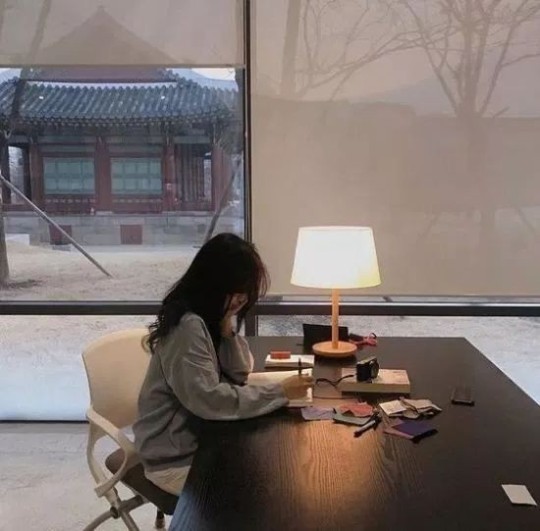
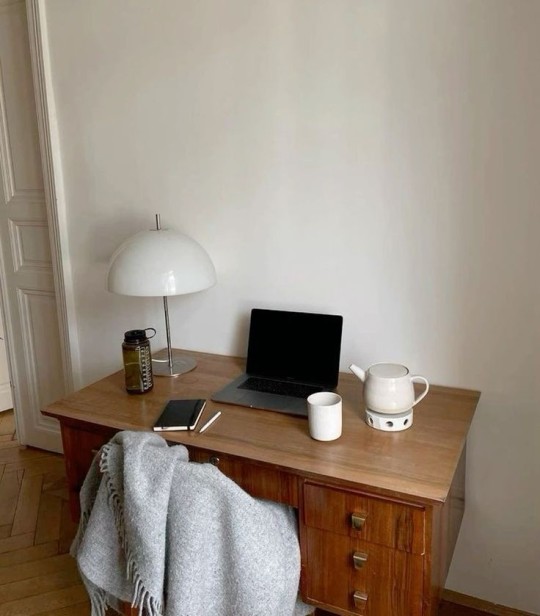
1. The power of a minimalist study space
Your study environment plays a crucial role in your ability to concentrate and absorb information. A cluttered desk or disorganized room can lead to distractions, stress, and reduced productivity. On the other hand, an orderly and minimalist space promotes clarity of thought and focus.
Why Minimalism Matters
Reduces Distractions A minimalist setup limits visual and mental distractions. With fewer items in your field of vision, your brain can focus more on the task at hand.
Promotes Calmness An organized space creates a sense of calm, reducing stress and anxiety, which are common barriers to effective studying.
Enhances Efficiency Knowing exactly where your materials are saves time and keeps you in the flow of your work, avoiding interruptions caused by searching for misplaced items.
How to Create the Ideal Study Space
Declutter Regularly Keep only essential items on your desk. Store books, papers, and other materials neatly in drawers or shelves.
Personalize Mindfully Add a few personal touches, like a plant or a motivational quote, but avoid overloading your space with unnecessary objects.
Ensure Comfort Choose a comfortable chair, good lighting, and a desk at the right height to prevent physical discomfort during long study sessions.

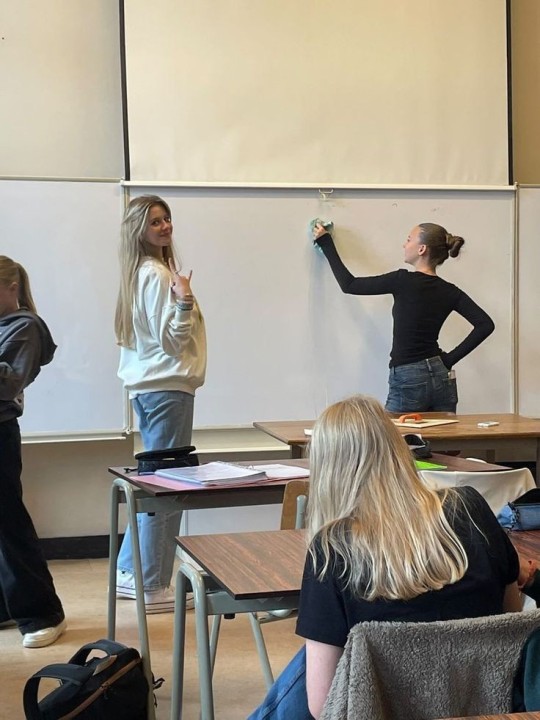
2. Mastering active learning techniques
Active learning is the cornerstone of effective studying. Unlike passive methods, such as simply reading or highlighting, active learning engages multiple areas of your brain, enhancing comprehension and retention.
Key Active Learning Techniques
Summarization After reading a section of your textbook or attending a lecture, summarize the main points in your own words. This forces you to process the information deeply, improving understanding and memory.
Self-Testing Regularly quiz yourself on the material. This not only reinforces your knowledge but also highlights areas where you need further review. Tools like flashcards or apps such as Anki can be particularly effective.
Teaching Others Explaining concepts to others is one of the best ways to solidify your understanding. This could be done with a study partner, in a group setting, or even by teaching an imaginary audience.
Mind Mapping Create visual representations of the material, such as diagrams or mind maps. This technique helps you see connections between ideas and organizes complex information into a more digestible format.
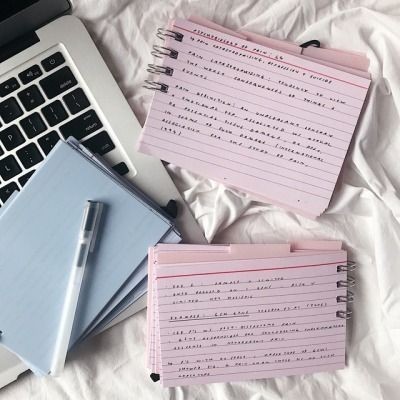
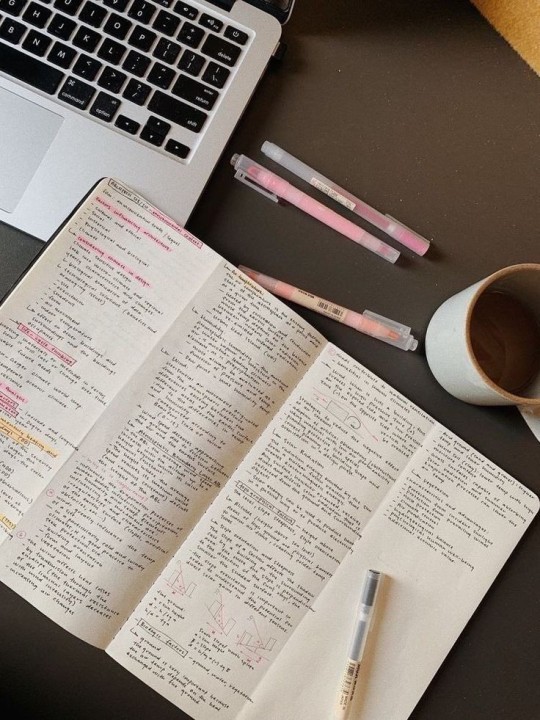
3. Study aids for enhanced learning
Study aids are tools and resources that can support and enhance your learning process. When used correctly, they can make studying more efficient and effective.
Types of Study Aids:
Flashcards Ideal for memorization, flashcards help reinforce knowledge through active recall and spaced repetition. Digital flashcards allow for easy organization and accessibility on the go.
Mind Maps These visual tools help break down complex concepts and illustrate relationships between ideas, making it easier to grasp and remember large amounts of information.
Practice Tests Taking practice exams familiarizes you with the format and types of questions you might encounter, reducing test anxiety and highlighting areas for improvement.
Educational Apps Numerous apps cater to various aspects of studying, from organization (Notion, Evernote) to subject-specific learning (Duolingo for languages).
How to Use Study Aids Effectively
Incorporate Them Regularly Don’t wait until the last minute to use study aids. Regular integration into your study routine ensures continuous reinforcement of material.
Customize Your Tools Tailor flashcards, mind maps, and other aids to suit your learning style and the specific material you need to master.
Combine Methods Use a mix of study aids to address different types of content and to keep your study sessions dynamic and engaging.
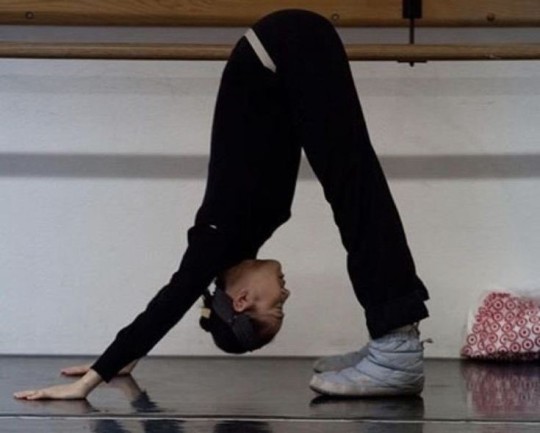

4. Staying Healthy
MENS SANA IN CORPORE SANO
The ancient adage "mens sana in corpore sano," meaning "a healthy mind in a healthy body," underscores the importance of physical well-being in achieving academic success. Neglecting your health can lead to burnout, decreased cognitive function, and lower academic performance.
Physical Health and Academic Performance
Nutrition A balanced diet fuels your brain, improving concentration, memory, and energy levels. Incorporate brain-boosting foods like fruits, vegetables, nuts, and fish rich in omega-3 fatty acids.
Exercise Regular physical activity increases blood flow to the brain, enhances mood through the release of endorphins, and reduces stress. Even short, daily exercise sessions can make a significant difference in your mental clarity and stamina.
Sleep Adequate sleep is essential for memory consolidation and cognitive function. Aim for 7-9 hours of quality sleep each night to ensure you are well-rested and ready to tackle your studies.
Mental Health and Academic Success
Stress Management Practice mindfulness techniques such as meditation or deep breathing to manage stress. Regular breaks during study sessions can also prevent burnout.
Work-Life Balance Ensure you have time for relaxation and social activities. A balanced life contributes to mental well-being, which in turn supports academic success.
Positive Mindset Cultivate a growth mindset, viewing challenges as opportunities for growth rather than as obstacles. This perspective not only enhances resilience but also keeps you motivated in your academic pursuits.
[photos from Pinterest]
#beauty tips#dream girl tips#glow up tips#health tips#study tips#study motivator#study blog#studyspo#study motivation#studying#studyblr#study aesthetic#phdblr#phd life#undergraduate#gradblr#uni studyspo#uni studyblr#uni blogging#uni student#it girl#that girl#clean girl#hyper feminine#becoming that girl#healthy girl#pink pilates girl#this is what makes us girls#weight loss#productivityboost
458 notes
·
View notes
Text
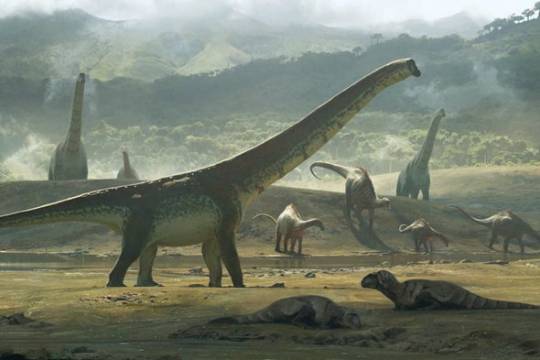
[ Argentinosaurus, a giant sauropod, illustrated by Chase Stone. ]
"Of all the animals ever to have roamed the planet, the iconic long-necked, long-tailed dinosaurs known as sauropods stand unrivaled. No other terrestrial creatures have come close to attaining their colossal sizes. They overshadowed all other dinosaurs, from the duck-billed hadrosaurs and the horned ceratopsians to the armored ankylosaurs and predatory tyrannosaurs. Even the mightiest land mammals—mammoths and rhinoceroslike beasts that were up to twice as heavy as the largest elephants alive today—were featherweights compared with the biggest sauropods.
From an evolutionary perspective, this singularity makes sauropods an intriguing anomaly. Evolution is rampant with examples of convergence, in which the same feature evolves more than once independently in different groups of organisms. A classic example of convergence is powered flight—flapping wings evolved in birds, bats, pterosaurs and insects, but the particular bones or other structures making up the wings differ among the groups, attesting to their independent evolutionary origins. Convergence in evolution is very common even when it comes to complicated features: warm-bloodedness, eyes that can move and focus, bipedal locomotion, the loss of limbs, the use of tools, and live birth all evolved multiple times in different animal groups. Convergence is widespread in the plant kingdom as well: carnivorous plants evolved at least a dozen times, roots evolved more than once, and even arborescence—plants taking the form of trees—evolved more than once. With convergence so common in nature, sauropods' uniqueness in size is special in itself. No other land animal has approached even a third of the largest sauropods' weight. What makes sauropods stand out from the crowd, both literally and figuratively?"
Read more: "How Sauropod Dinosaurs Became the Biggest Land Animals Again and Again" by Michael D. D'Emic.
#palaeoblr#Palaeontology#Paleontology#Sauropods#Dinosaurs#Art#Article#Argentinosaurus#Cretaceous#Mesozoic#Prehistoric#Extinct
1K notes
·
View notes
Note
Max I have a linguistics question. And I will even free your chess ask from purgatory as payment. So there's this thing that goes around saying that US English pronunciations are more similar to old English than British English. Is there any truth to this, and how would we know one way or the other?
There is some kernel of truth in it that is getting exaggerated or oversimplified.
Let me start off by answering, in a general sense, the question "how would we know one way or the other?"
The Part Where I Accidentally (on Purpose) Wrote a Brief Introduction to Historical Linguistics
Phonological change (change in the pronunciation of a language) doesn't work in the way we might naively expect it to. I think that most people imagine phonological change as basically happening by way of each word in the language taking a random walk through pronunciation-space as time goes along. Like genes in a genome, randomly mutating. This is not what happens. Rather, phonological change occurs via rewrite rules, which find-and-replace particular sequences of sounds in a systematic way across the entire lexicon. For example, such a rule might replace a [t] sound with an [s] sound whenever it precedes an [i] sound. This will occur in all words in the language at once, in a uniform way. These find-and-replace rules are called regular sound changes, and they pile up over time, constituting phonological change.
This fact—the regularity of sound change—is known as the Neogrammarian hypothesis.
The above picture is an oversimplification. There are a variety of exceptions and apparent-exceptions to the regularity of sound change, and dealing with them is one of the major challenges of historical linguistics. But as a model, the Neogrammarian hypothesis is extraordinarily powerful. It is literally what makes historical linguistics possible at all. The upshot of the Neogrammarian hypothesis is that when two languages are related, their vocabulary won't just be "kinda similar" in some nebulous sense, it will demonstrate systematic, predictable correspondences in sound between cognate vocabulary.
Here's an illustration of this, a comparative table of some cognates in Polynesian (from Wikipedia):
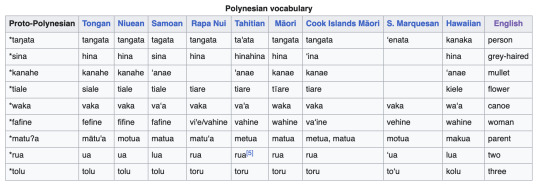
If you look at any two columns of this table, you'll start to notice correspondences. Tongan and Niuean /k/ correspond to Samoan /ʔ/ (a glottal stop, written with a apostrophe). This correspondence is one-to-one. Samoan /s/ corresponds to Tongan and Niuean /h/, but the reverse is not true: some instances of Tongan and Niuean /h/ correspond to Samoan ∅ (nothing). Tongan /s/, on the other hand, corresponds to Niuean and Samoan /t/, but only before /i/. Etc. etc.
These are systematic sound correspondences, born of Neogrammarian sound change from a common ancestor.
Ok, on the left hand side you will notice a column that says "Proto-Polynesian". The words in this column are all marked with *, indicating that they are reconstructed forms. They are linguists' best guess as to what the original, ancestral form of these words would have been in the Polynesian languages' common ancestor. There are various ways linguists make these reconstructions. First of all, we can do it by sheer majority rule: if most of the languages in a family reflect a sound as X, and only one or a few reflect it as Y, then (all else being equal and assuming the tree is flat) it is more likely that the original word had X. Almost all these languages have /t/ as the first sound in "person" (row 1), whereas Marquesan has /ʔ/ and Hawaiian has /k/. Thus the ancestral sound is reconstructed as /t/.
But there are other, more sophisticated tools that can be used. For instance, we know a certain amount about what sorts of sound changes are likely to occur and what sorts are not. Thus, for instance, an /s/ is reconstructed as the first sound in "grey haired" (row 2), even though the majority of languages have /h/. This is because we already know that s -> h is a fairly common sound change (and indeed corresponds to a known phonological process found presently in many languages—debuccalization), whereas h -> s is a much rarer change (in fact, I suspect wholly unattested), and corresponds to no known phonological process or phonetic explanation.
Finally, we can rule out reconstructions when the sound change needed to create them would not be a function. Consider, for instance, that the majority of the words in row 3 have no consonant sound at all before the final /e/. But the reconstruction features a consonant /h/ there. If we posit ∅ as initial instead, we have to come up with a sound change that explains how the /h/ got there. ∅ -> h doesn't work, because that would put /h/ everywhere! How about something like "∅ -> h between two vowels" (linguists would notate this change as ∅ -> h / V_V). That would work, but we see other instances of adjacent vowels (e.g. in row 4) with no /h/ between them, so that can't be it. Maybe "∅ -> h between /a/ and /e/" (∅ -> h / a_e). We can't rule this out on the basis of this chart, but we probably could by looking at more vocabulary.
And so on, and so forth. In general, we want to posit the simplest set of sound changes possible, in which the changes themselves are as probable as possible, in order to explain the data. These putative changes can then by checked against all sorts of outside observations, such as
descriptions of pronunciations in historical texts
past loanwords into languages whose phonological histories are already known with confidence
epigraphic data from archeology (not very applicable to Polynesian, unless we decipher rongorongo)
newly collected data from modern languages in the same family
evidence from rhyme schemes or alliteration schemes used in poetry composed in the past
etc.
to see if they hold up.
The Part Where I Answer Your Question
Ok, right. American English and "British English" (I assume this means Received Pronunciation) are two related language varieties. Thus, they share systematic sound correspondences, and we can try to reconstruct their common ancestor. Also the British Isles have produced an extraordinary number of texts in the past thousand years, including poetry and actual linguistic descriptions of various dialects at various points in time, which we can check these reconstructions against.
But actually you don't need most of that to identify a few ways in which (most) American English dialects are more conservative than Received Pronunciation. For one, Received Pronunciation has dropped /r/ at the end of a syllable (in English dialectological jargon it is "non-rhotic"), whereas General American English hasn't. There are some associated vowel changes too. One way or another, the /r/ is plainly original: elision of /r/ is more common and phonetically plausible than insertion of /r/ in a bunch of specific post-vocalic positions would be, /r/ is written in the orthography, historical descriptions of the language talk about an /r/ sound, etc. etc.
In other ways RP is more conservative. For example, GenAm has deleted /j/ (the "y" sound) in a specific phonological environment ([+coronal]_u) in words such as tube, GenAm /tuːb/, RP /tjuːb/.
Is "American English more conservative than RP" overall? I don't really think so. Certainly it has preserved a number of salient features that RP has lost, such as syllable-final /r/ and (in some dialects) /hw/ in words like what, and so on. But there's other senses in which RP is more conservative. And this is not even to mention the other dialects of Britain, which are manifold and much more diverse than the dialects of America. As to the strict question of the relative phonological conservatism of GenAm and RP, I think someone with more detailed knowledge of English historical phonological would have to come in and answer. Perhaps @yeli-renrong can comment.
623 notes
·
View notes
Text
✨ Creating Your Grimoire ✨
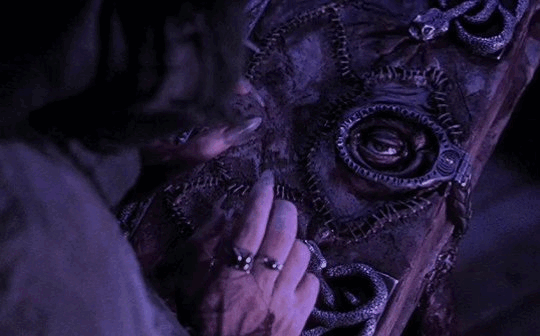
In the realm of witchcraft and the arcane arts, a grimoire is a sacred vessel—a repository for your magical knowledge, spells, and experiences. To create your very own grimoire is to embark on a magical journey, a testament to your personal growth and a reflection of your unique spiritual path. With each page, you breathe life into a magical world that is uniquely yours. 🌙📜🔮
So, let us delve into the mystic arts and learn how to craft your very own grimoire, a treasured companion on your magical journey:
✨ 1. Choose Your Tools: Begin by selecting a journal or a notebook that resonates with you. It could be leather-bound, handcrafted, or a simple, beautifully designed book. Let your intuition guide you.
✨ 2. Dedicate Your Grimoire: Before you start filling its pages, dedicate your grimoire to your magical practice. Create a ceremony or ritual that signifies its importance in your spiritual journey.
✨ 3. Organize Your Content: Decide on the sections or categories for your grimoire. Common sections include spells, herbs, crystals, divination, moon phases, and personal reflections. Organizing your content will make it easier to reference.
✨ 4. Decorate with Intention: Use art, symbols, and colors that hold significance in your practice. Incorporate symbols, runes, and illustrations that resonate with your magical path. Each stroke of your pen can carry intention.
✨ 5. Record Your Spells and Rituals: Document your spells and rituals with care. Include ingredients, steps, and the outcomes. Personalize them to make them your own and infuse them with your energy.
✨ 6. Herbal and Crystal Wisdom: Devote sections to the properties and uses of herbs and crystals. Describe their magical associations and how to work with them in your spells and rituals.
✨ 7. Lunar and Planetary Magic: Dedicate pages to the phases of the moon and the influence of planetary energies. Include your observations and experiences with these celestial guides.
✨ 8. Divination and Tarot: Share your insights about divination methods like tarot, runes, or scrying. Document your readings and interpretations.
✨ 9. Dream and Meditation Journal: Dedicate a portion to dream and meditation experiences. Record your visions, insights, and messages received during your spiritual journeys.
✨ 10. Personal Reflections: Your grimoire is not just a book of facts but a record of your spiritual evolution. Write about your experiences, your magical progress, and how your practice has shaped you.
✨ 11. Protection and Secrecy: Consider creating a page or section dedicated to protective spells or enchantments to safeguard the contents of your grimoire.
✨ 12. Regularly Update: Your grimoire is a living, evolving document. As you learn, grow, and experience, continue to add to its pages and update your knowledge.
🌟🔮🌟
As you craft your grimoire, remember that it is a reflection of your unique connection to the magical world. With each entry, you breathe life into your practice, making it a powerful, personalized tool for your mystical journey. May your grimoire be a testament to your magical evolution, a record of your discoveries, and a key to the secrets of the universe.
📜🔮✨ Blessed be, as you embark on this enchanting journey of grimoire creation. 📜🔮✨
#witchy#witches of tumblr#witchblr#witchcraft#magick#grimoire#book of shadows#baby witch#witch community#witchcraft community#witchlife#witchy tips#witchy things#baby witches
655 notes
·
View notes
Text
CLİPART - DRAGON+ (5)

The historical development of farm clipart has evolved significantly over time, reflecting changes in artistic styles, technological advancements, and cultural influences. Initially, farm clipart consisted of simplistic and rudimentary drawings of basic farm elements such as barns, animals, and crops. As graphic design tools and techniques advanced, farm clipart became more detailed and realistic, capturing the essence of farm life with greater precision and creativity. With the rise of digital platforms and online marketplaces, farm clipart has become more accessible and diverse, offering a wide range of options for designers and creators to incorporate farm-related visuals into their projects. The evolution of farm clipart mirrors the evolution of farming practices and the agricultural industry, showcasing the deep connection between art, technology, and cultural representation in visual storytelling.
Similarly, the evolution of history clipart has followed a trajectory of innovation and adaptation to changing artistic styles and educational trends. Historically, history clipart primarily featured iconic historical figures, landmarks, and events depicted in a simplistic and educational manner. As digital platforms and educational resources developed, history clipart expanded to include a broader range of topics, styles, and visual interpretations. Modern history clipart encompasses a diverse array of historical themes, from ancient civilizations to contemporary global events, catering to the varied needs of educators, students, and enthusiasts. The evolution of history clipart reflects society's evolving interest in history, visual literacy, and the power of imagery to convey complex historical narratives in a compelling and informative way.
The trends in food clipart styles have undergone a transformation in response to changing culinary preferences, design aesthetics, and cultural influences. Initially, food clipart featured traditional depictions of common food items such as fruits, vegetables, and dishes in a realistic and straightforward manner. However, as culinary diversity and visual storytelling evolved, food clipart began to incorporate more stylized, artistic, and thematic elements to convey the richness and diversity of global cuisines. From minimalist food illustrations to vibrant and whimsical food compositions, the trends in food clipart styles reflect the fusion of creativity, technology, and culinary appreciation in visual design. By exploring different food clipart styles, designers and content creators can enhance their projects with visually appealing and culturally resonant food imagery that engages and inspires audiences.
341 notes
·
View notes
Text
I never did a long thing about scrimshaw, so it’s time! At 1 am, apparently.
I think scrimshaw is one of the most fascinating material goods to emerge from the history of the American whaling industry (which is the context I’m discussing here, though of course the artform exists across numerous eras and cultures outside this brief blip of nautical history).
It’s one way to see amatuer art that usually doesn’t often survive in other forms. To see the art project of an ordinary man who was bored and needed something to do with his hands. Others were highly skilled craftsman, creating intricate engravings or mechanically expert tools. The most common scrimshaw was images etched on sperm whale teeth. Sometimes those images came from the maker’s own imagination and sometimes they were copied illustrations. Ships & whaling scenes, women, mythical figures, and patriotic symbols make up the bulk of the visual language in those pieces that survive.
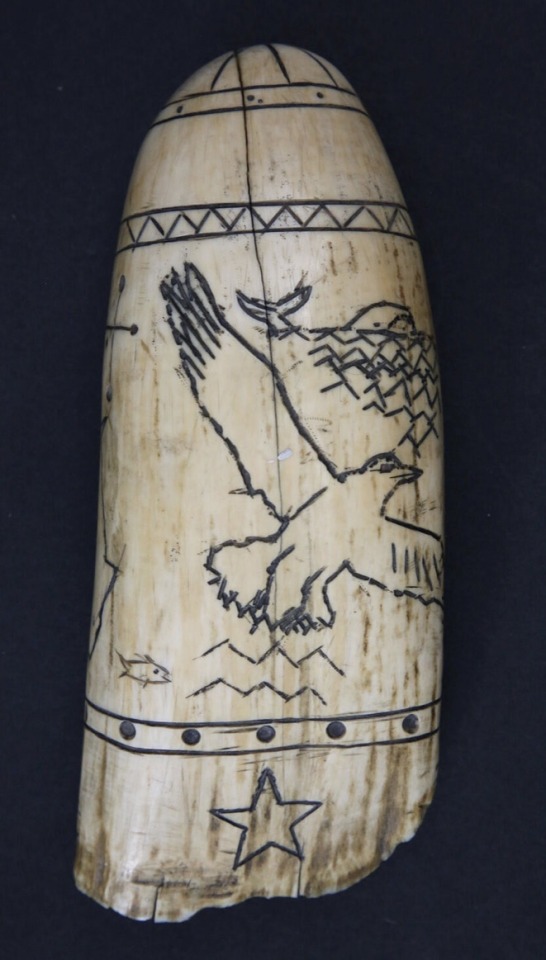
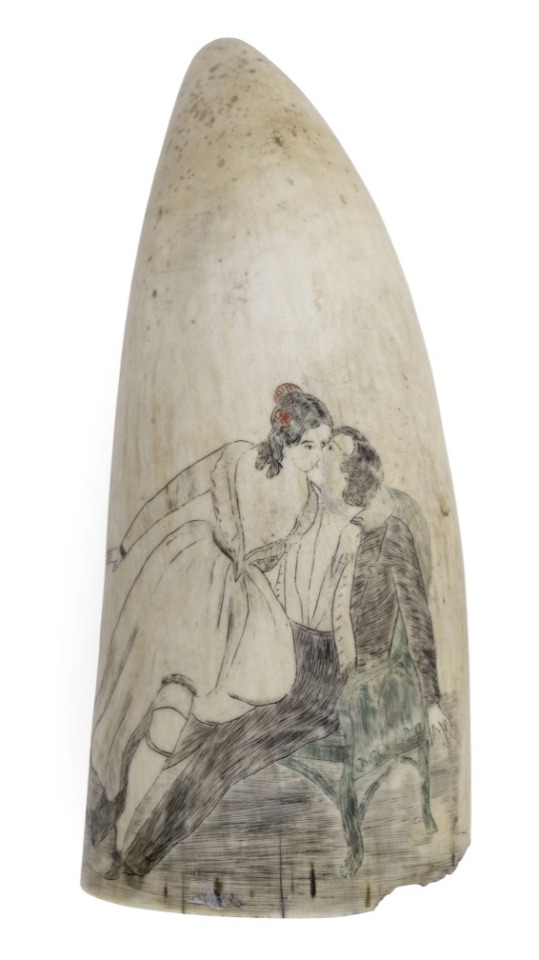
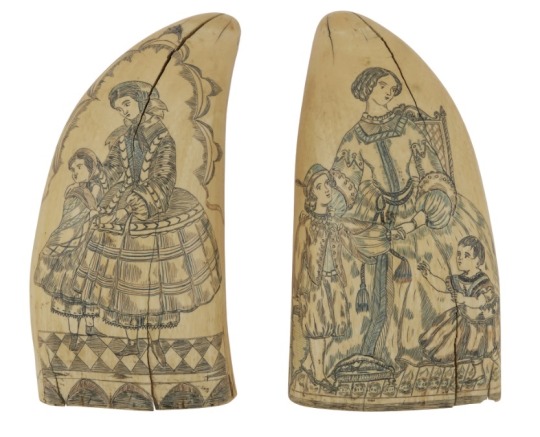
But alongside the teeth were all a manner of carved items: canes, candle holders, pie crimpers, children’s toys, sewing boxes, yarn swifts, corset busks. So much bone fashioned into quiet little homegoods. And it’s that contradiction within scrimshaw that fascinates me. The brutality of the industry, this ivory from an animal that frankly died terribly, that’s then softened into a little domestic item. An object that could have hours to years of work put into it. Some were made to be sold but many were made as gifts. In the long stretches of boredom at sea, in the lull between back-breaking work and life-threatening terror, scrimshaw gives a window into where the minds of these men continually turned. It shows where their hearts were and what they were holding on to over all the years they spent adrift in saltwater and blood and oil. That’s the poetry I see in scrimshaw. Pain and love and longing and creativity and playfulness all bound together in these complicated little pieces that found their way out of the hands of their anonymous makers to preserve a small part of their story.
Some scrimshanders names are known. Frederick Myrick is one of the most well known American whalers, not so much for the scope of his life (of which little is known) but for his scrimshaw. Born in Nantucket in 1808, he first went whaling in 1825 on the Columbus and then again on the Susan 1826-29. In the last few months aboard the Susan, Myrick engraved over 30 sperm whale teeth, all depicting the ship he was on (though there are a handful that depict other vessels). He signed and dated nearly each one. These pieces are often referred to as ‘Susan’s Teeth’ now, and when one comes up at auction it’s not unusual for it to sell for six figures.
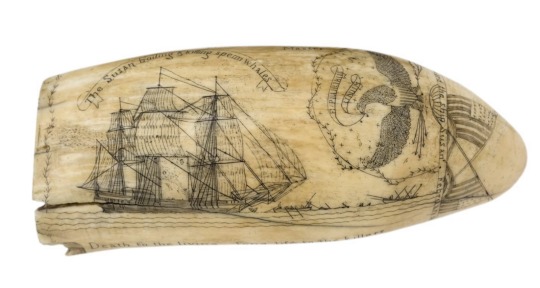
Many of the teeth Myrick scrimshawed included an inscribed couplet of his devising: A dark wish for luck that succinctly gets at the violent and unstable heart of American whaling.
“Death to the living, long life to the killers
Success to sailor’s wives, and greasy luck to whalers”
Sometimes large scenes were etched on panbones as well.

Moving from scrimshaw on teeth and jawbones, pie crimpers are some of the more common sculptural items. Popular motifs included animals (dogs, snakes, and unicorns/hippocampus are big), body parts (mostly clenched fists or lady’s legs), and geometric designs.
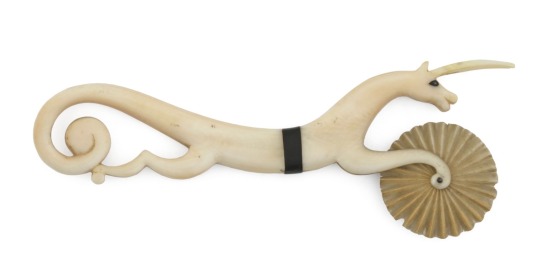
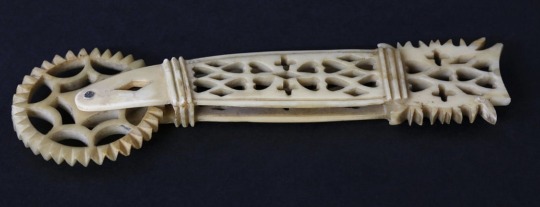

Others were more mechanically complicated, such as automatons and children’s toys with moving parts and gears. Here’s one of a small rocking sailboat, perhaps made for someone’s child or younger sibling.
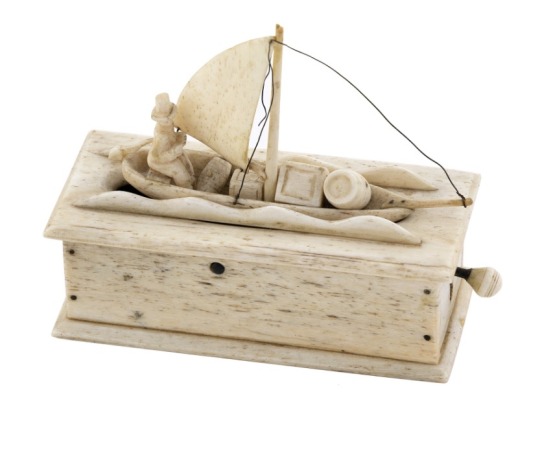
Sometimes a particular creative fellow created something more eccentric, like this wild writing desk kit fashioned out of a carved panbone and sperm whale teeth.

Another frequently scrimshawed object was a corset busk that would be slid into the front of the garment in order to maintain the posture. A rather private item compared to others. And one with a very on-the-nose message of wearing close to one’s heart the memory of someone who’d be gone for 3-4 years, who might never come home again. On some level, so many of these daily objects whispered ‘forget me not’, ‘think of me while I’m gone’.

There’s something tender to all the various domestic items that were fashioned on the job so long and far from home, but it’s the yarn swifts that really captivate me. They were one of the most complicated pieces of scrimshaw to make, with over one hundred different pieces that would have to be carved. It could take someone the length of the voyage (2-4 years) to complete a single one. Unlike teeth which were comparatively very quick to make and were frequently intended to be sold, it’s very unlikely that a swift was made with the aim of selling it because of the significant labor that went into it. They were almost certainly all gifts, and very special ones at that. Every time I see one I can just feel the love towards its intended recipient radiating off of it.
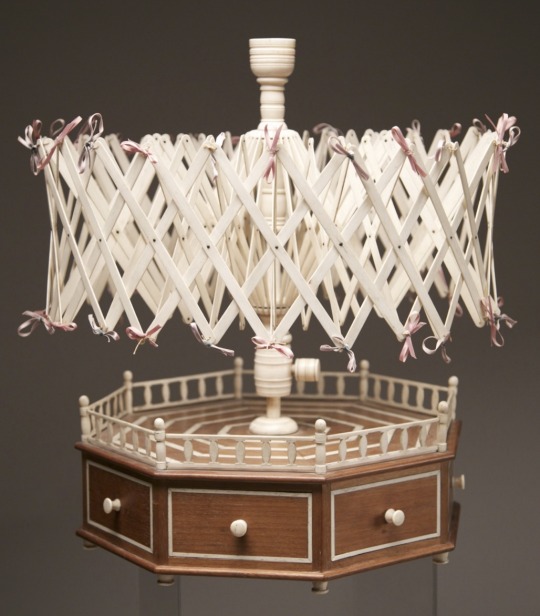
Scrimshaw captures a specific snapshot of a moment in time. On a broader scale it’s a surviving reminder of a bloody industry that flared up and winked out, preserved in the form of a long-lost ship and the spout of a long-dead whale inked on a yellowing tooth. But that snapshot also reveals the emotional world of the men who were caught up in such an industry: what they valued, what they thought about, what they missed, and what they wanted to be remembered of them.
2K notes
·
View notes
Text
A year in illustration, 2023 edition (part one)
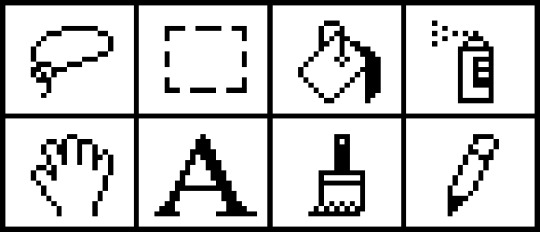
(This is part one; part two is here.)
I am objectively very bad at visual art. I am bad at vision, period – I'm astigmatic, shortsighted, color blind, and often miss visual details others see. I can't even draw a stick-figure. To top things off, I have cataracts in both eyes and my book publishing/touring schedule is so intense that I keep having to reschedule the surgeries. But despite my vast visual deficits, I thoroughly enjoy making collages for this blog.
For many years now – decades – I've been illustrating my blog posts by mixing public domain and Creative Commons art with work that I can make a good fair use case for. As bad as art as I may be, all this practice has paid off. Call it unseemly, but I think I'm turning out some terrific illustrations – not all the time, but often enough.
Last year, I rounded up my best art of the year:
https://pluralistic.net/2022/12/25/a-year-in-illustration/
And I liked reflecting on the year's art so much, I decided I'd do it again. Be sure to scroll to the bottom for some downloadables – freely usable images that I painstakingly cut up with the lasso tool in The Gimp.

The original AD&D hardcover cover art is seared into my psyche. For several years, there were few images I looked at so closely as these. When Hasbro pulled some world-beatingly sleazy stuff with the Open Gaming License, I knew just how to mod Dave Trampier's 'Eve Of Moloch' from the cover of the Players' Handbook. Thankfully, bigger nerds than me have identified all the fonts in the image, making the remix a doddle.
https://pluralistic.net/2023/01/12/beg-forgiveness-ask-permission/#whats-a-copyright-exception
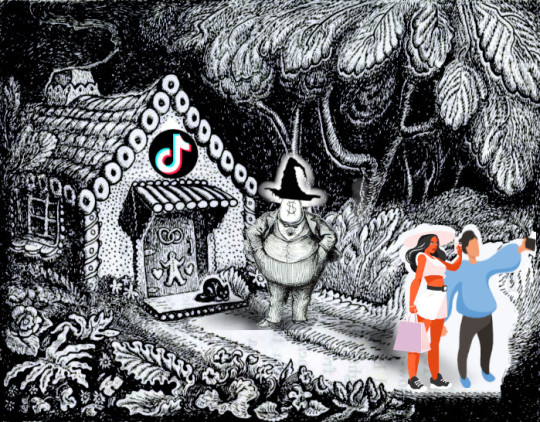
Even though I don't keep logs or collect any analytics, I can say with confidence that "Tiktok's Enshittification" was the most popular thing I published on Pluralistic this year. I mixed some public domain Brother's Grimm art, mixed with a classic caricature of Boss Tweed, and some very cheesy royalty-free/open access influencer graphics. One gingerbread cottage social media trap, coming up:
https://pluralistic.net/2023/01/21/potemkin-ai/#hey-guys
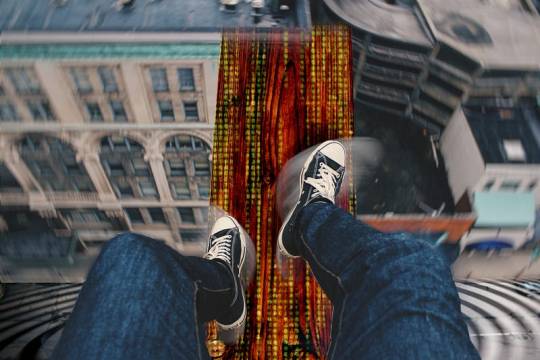
To illustrate the idea of overcoming walking-the-plank fear (as a metaphor for writing when it feels like you suck) I mixed public domain stock of a plank, a high building and legs, along with a procedurally generated Matrix "code waterfall" and a vertiginous spiral ganked from a Heinz Bunse photo of a German office lobby.
https://pluralistic.net/2023/01/22/walking-the-plank/

Finding a tasteful way to illustrate a story about Johnson & Johnson losing a court case after it spent a generation tricking women into dusting their vulvas with asbestos-tainted talcum was a challenge. The tulip (featured in many public domain images) was a natural starting point. I mixed it with Jesse Wagstaff's image of a Burning Man dust-storm and Mike Mozart's shelf-shot of a J&J talcum bottle.
https://pluralistic.net/2023/02/01/j-and-j-jk/#risible-gambit
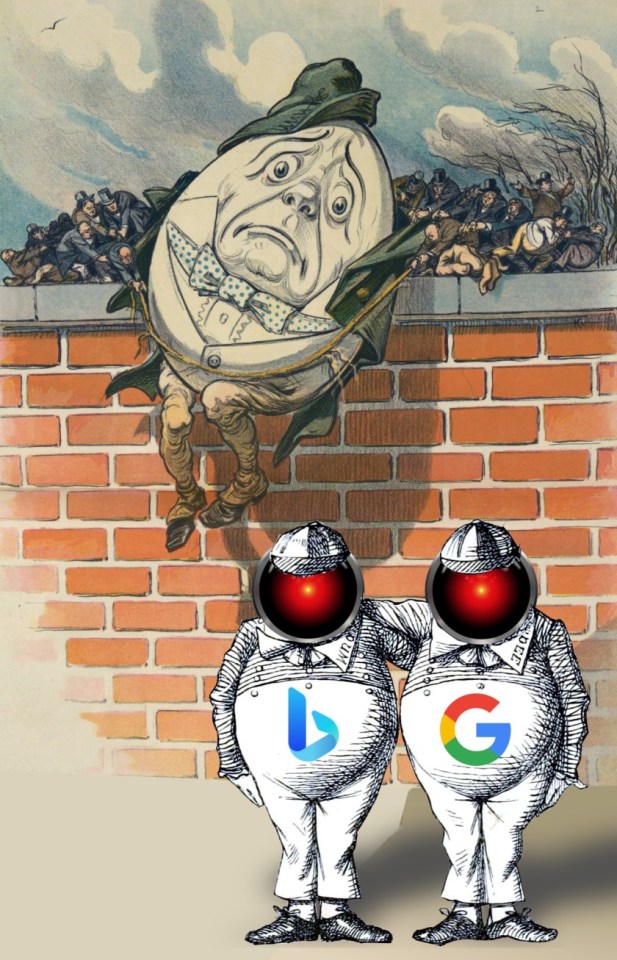
"Google's Chatbot Panic" is about Google's long history of being stampeded into doing stupid things because its competitors are doing them. Once it was Yahoo, now it's Bing. Tenniel's Tweedle Dee and Dum were a good starting point. I mixed in one of several Humpty Dumpty editorial cartoon images from 19th century political coverage that I painstakingly cut out with the lasso tool on a long plane-ride. This is one of my favorite Humpties, I just love the little 19th C businessmen trying to keep him from falling! I finished it off with HAL 9000's glowing red eye, my standard 'this is about AI' image, which I got from Cryteria's CC-licensed SVG.
https://pluralistic.net/2023/02/16/tweedledumber/#easily-spooked

Though I started writing about Luddites in my January, 2022 Locus column, 2023 was the Year of the Luddite, thanks to Brian Merchant's outstanding Blood In the Machine:
https://pluralistic.net/2023/09/26/enochs-hammer/#thats-fronkonsteen
When it came time to illustrate "Gig Work Is the Opposite of Steampunk," I found a public domain weaver's loft, and put one of Cryteria's HAL9000 eyes in the window. Magpie Killjoy's Steampunk Magazine poster, 'Love the Machine, Hate the Factory,' completed the look.
https://pluralistic.net/2023/03/12/gig-work-is-the-opposite-of-steampunk/

For the "small, non-profit school" that got used as an excuse to bail out Silicon Valley Bank, I brought back Humpty Dumpty, mixing him with a Hogwartsian castle, a brick wall texture, and an ornate, gilded frame. I love how this one came out. This Humpty was made for the SVB bailout.
https://pluralistic.net/2023/03/23/small-nonprofit-school/#north-country-school
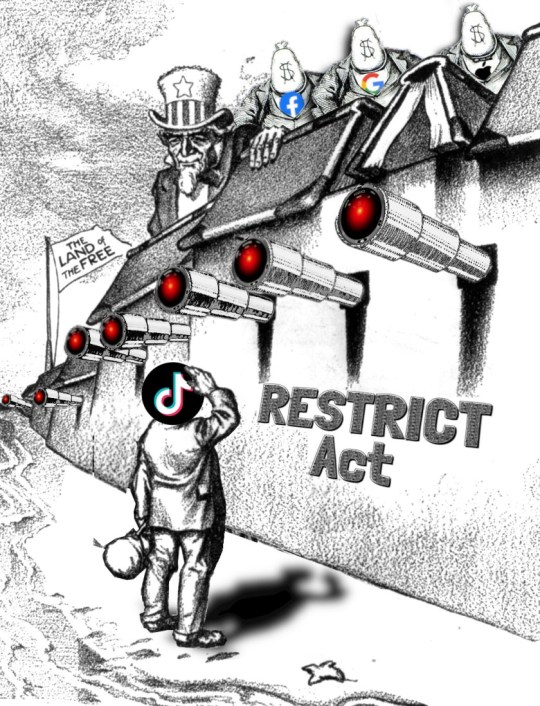
The RESTRICT Act would have federally banned Tiktok – a proposal that was both technically unworkable and unconstitutional. I found an early 20th century editorial cartoon depicting Uncle Sam behind a fortress wall that was keeping a downtrodden refugee family out of America. I got rid of most of the family, giving the dad a Tiktok logo head, and I put Cryteria's HAL9000 eyes over each cannonmouth. Three Boss Tweed moneybag-head caricatures, adorned with Big Tech logos, rounded it out.
https://pluralistic.net/2023/03/30/tik-tok-tow/#good-politics-for-electoral-victories

When Flickr took decisive action to purge the copyleft trolls who'd been abusing its platform, I knew I wanted to illustrate this with Lucifer being cast out of heaven, and the very best one of those comes from John Milton, who is conveniently well in the public domain. The Flickr logo suggested a bicolored streaming-light-of-heaven motif that just made it.
https://pluralistic.net/2023/04/01/pixsynnussija/#pilkunnussija

Old mainframe ads are a great source of stock for a "Computer Says No" image. And Congress being a public building, there are lots of federal (and hence public domain) images of its facade.
https://pluralistic.net/2023/04/04/cbo-says-no/#wealth-tax

When I wrote about the Clarence Thomas/Harlan Crow bribery scandal, it was easy to find Mr. Kjetil Ree's great image of the Supreme Court building. Thomas being a federal judge, it was easy to find a government photo of his head, but it's impossible to find an image of him in robes at a decent resolution. Luckily, there are tons of other federal judges who've been photographed in their robes! Boss Tweed with the dollar-sign head was a great stand-in for Harlan Crow (no one knows what he looks like anyway). Gilding Thomas's robes was a simple matter of superimposing a gold texture and twiddling with the layers.
https://pluralistic.net/2023/04/06/clarence-thomas/#harlan-crow
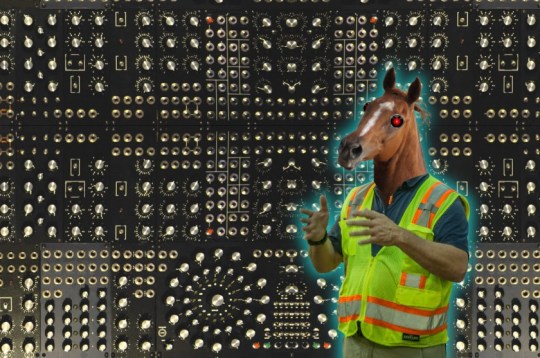
"Gig apps trap reverse centaurs in wage-stealing Skinner boxes" is one of my best titles. This is the post where I introduce the idea of "twiddling" as part of the theory of enshittification, and explain how it relates to "reverse centaurs" – people who assist machines, rather than the other way around. Finding a CC licensed modular synth was much harder than I thought, but I found Stephen Drake's image and stitched it into a mandala. Cutting out the horse's head for the reverse centaur was a lot of work (manes are a huuuuge pain in the ass), but I love how his head sits on the public domain high-viz-wearing warehouse worker's body I cut up (thanks, OSHA!). Seeing as this is an horrors-of-automation story, Cryteria's HAL9000 eyes make an appearance.
https://pluralistic.net/2023/04/12/algorithmic-wage-discrimination/#fishers-of-men
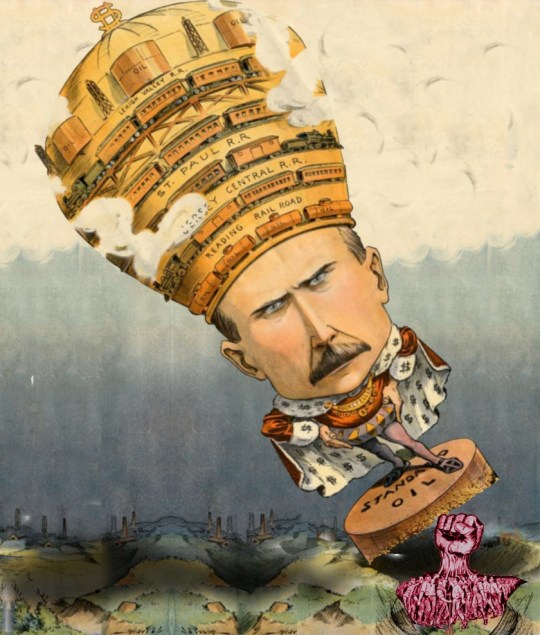
Rockefeller's greatest contribution to our culture was inspiring many excellent unflattering caricatures. The IWW's many-fists-turning-into-one-fist image made it easy to have the collective might of workers toppling the original robber-baron.
https://pluralistic.net/2023/04/14/aiming-at-dollars/#not-men
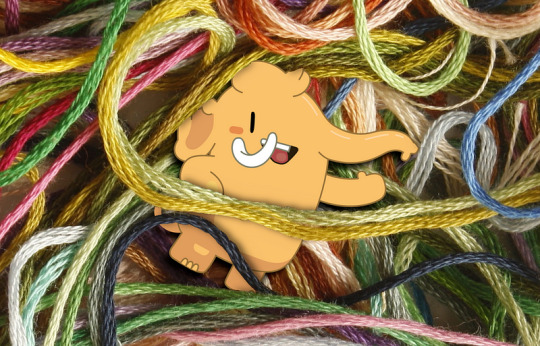
I link to this post explaining how to make good Mastodon threads at least once a week, so it's a good thing the graphic turned out so well. Close-cropping the threads from a public domain yarn tangle worked out great. Eugen Rochko's Mastodon logo was and is the only Affero-licensed image ever to appear on Pluralistic.
https://pluralistic.net/2023/04/16/how-to-make-the-least-worst-mastodon-threads/
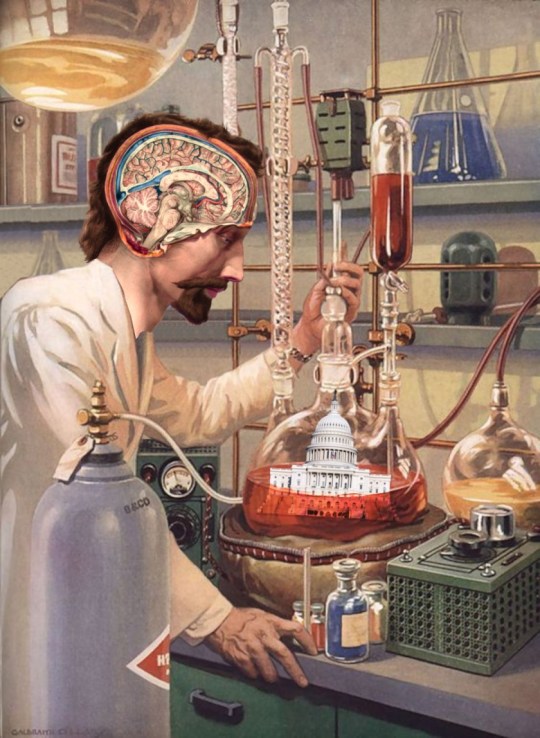
I spent hours on the sofa one night painstakingly cutting up and reassembling the cover art from a science fiction pulp. I have a folder full of color-corrected, high-rez scans from an 18th century anatomy textbook, and the cross-section head-and-brain is the best of the lot.
https://pluralistic.net/2023/05/04/analytical-democratic-theory/#epistocratic-delusions

Those old French anatomical drawings are an endless source of delight to me. Take one cross-sectioned noggin, mix in an old PC mainboard, and a vector art illo of a virtuous cycle with some of Cryteria's HAL9000 eyes and you've got a great illustration of Google's brain-worms.
https://pluralistic.net/2023/05/14/googles-ai-hype-circle/
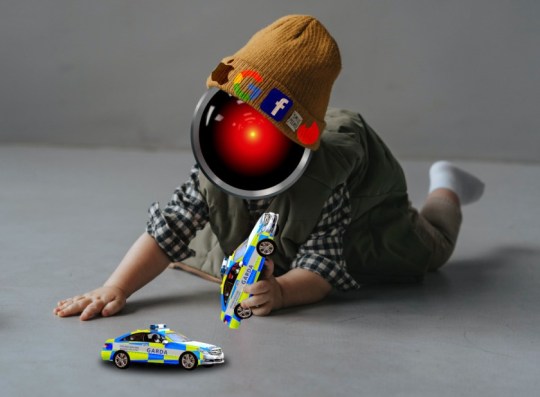
Ireland's privacy regulator is but a plaything in Big Tech's hand, but it's goddamned hard to find an open-access Garda car. I manually dressed some public domain car art in Garda livery, painstakingly tracing it over the panels. The (public domain) baby's knit cap really hides the seams from replacing the baby's head with HAL9000's eye.
https://pluralistic.net/2023/05/15/finnegans-snooze/#dirty-old-town
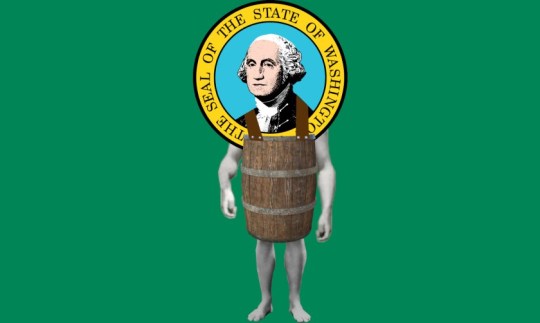
Naked-guy-in-a-barrel bankruptcy images feel like something you can find in an old Collier's or Punch, but I came up snake-eyes and ended up frankensteining a naked body into a barrel for the George Washington crest on the Washington State flag. It came out well, but harvesting the body parts from old muscle-beach photos left George with some really big guns. I tried five different pairs of suspenders here before just drawing in black polyhedrons with little grey dots for rivets.
https://pluralistic.net/2023/06/03/when-the-tide-goes-out/#passive-income
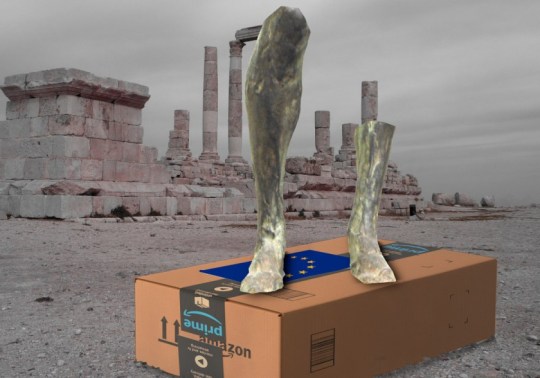
Illustrating Amazon's dominance over the EU coulda been easy – just stick Amazon 'A's in place of the yellow stars that form a ring on the EU flag. So I decided to riff on Plutarch's Alexander, out of lands to conquer. Rama's statue legs were nice and high-rez. I had my choice of public domain ruin images, though it was harder thank expected to find a good Amazon box as a plinth for those broken-off legs.
https://pluralistic.net/2023/06/14/flywheel-shyster-and-flywheel/#unfulfilled-by-amazon

God help me, I could not stop playing with this image of a demon-haunted IoT car. All those reflections! The knife sticking out of the steering wheel, the multiple Munsch 'Scream'ers, etc etc. The more I patchked with it, the better it got, though. This one's a banger.
https://pluralistic.net/2023/07/24/rent-to-pwn/#kitt-is-a-demon
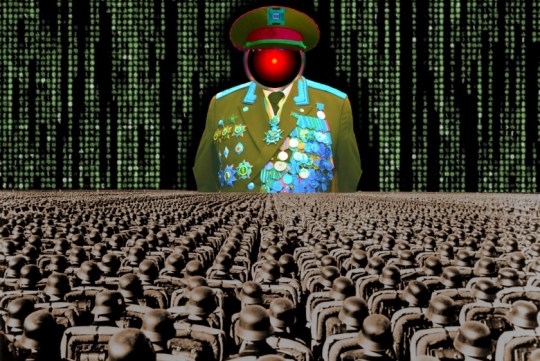
To depict a "data-driven dictatorship," I ganked elements of heavily beribboned Russian military dress uniforms, replacing the head with HAL9000's eye. I turned the foreground into the crowds from the Nuremberg rallies and filled the sky with Matrix code waterfall.
https://pluralistic.net/2023/07/26/dictators-dilemma/#garbage-in-garbage-out-garbage-back-in

The best thing about analogizing DRM to demonic possession is the wealth of medieval artwork to choose from . This one comes from the 11th century 'Compendium rarissimum totius Artis Magicae sistematisatae per celeberrimos Artis hujus Magistros.' I mixed in the shiny red Tesla (working those reflections!), and a Tesla charger to make my point.
https://pluralistic.net/2023/07/28/edison-not-tesla/#demon-haunted-world

Yet more dividends from those old French anatomical plates: a flayed skull, a detached jaw, a quack electronic gadget, a Wachowski code waterfall and some HAL 9000 eyes and you've got a truly unsettling image of machine-compelled speech.
https://pluralistic.net/2023/08/02/self-incrimination/#wei-bai-bai

I had no idea this would work out so well, but daaaamn, crossfading between a Wachowski code waterfall and a motherboard behind a roiling thundercloud is dank af.
https://pluralistic.net/2023/08/03/there-is-no-cloud/#only-other-peoples-computers

Of all the turkeys-voting-for-Christmas self-owns conservative culture warriors fall for, few can rival the "banning junk fees is woke" hustle. Slap a US-flag Punisher logo on and old-time card imprinter, add a GOP logo to a red credit-card blank, and then throw in a rustic barn countertop and you've got a junk-fee extracter fit for the Cracker Barrel.
https://pluralistic.net/2023/08/04/owning-the-libs/#swiper-no-swiping

Putting the Verizon logo on the Hinderberg was an obvious gambit (even if I did have to mess with the flames a lot), but the cutout of Paul Marcarelli as the 'can you hear me now?' guy, desaturated and contrast-matched, made it sing.
https://pluralistic.net/2023/08/10/smartest-guys-in-the-room/#can-you-hear-me-now

Note to self: Tux the Penguin is really easy to source in free/open formats! He looks great with HAL9000 eyes.
https://pluralistic.net/2023/08/18/openwashing/#you-keep-using-that-word-i-do-not-think-it-means-what-you-think-it-means

Rockwell's self-portrait image is a classic; that made it a natural for a HAL9000-style remix about AI art. I put a bunch of time into chopping and remixing Rockwell's signature to give it that AI look, and added as many fingers as would fit on each hand.
https://pluralistic.net/2023/08/20/everything-made-by-an-ai-is-in-the-public-domain/
(Images: Heinz Bunse, West Midlands Police, Christopher Sessums, CC BY-SA 2.0; Mike Mozart, Jesse Wagstaff, Stephen Drake, Steve Jurvetson, syvwlch, Doc Searls, https://www.flickr.com/photos/mosaic36/14231376315, Chatham House, CC BY 2.0; Cryteria, CC BY 3.0; Mr. Kjetil Ree, Trevor Parscal, Rama, “Soldiers of Russia” Cultural Center, Russian Airborne Troops Press Service, CC BY-SA 3.0; Raimond Spekking, CC BY 4.0; Drahtlos, CC BY-SA 4.0; Eugen Rochko, Affero; modified)
#pluralistic#illustration#collage#fair use#creative commons#stock art#blogging#art#practice makes perfect
232 notes
·
View notes
Note
How do you write a flashback? When a character remembers something they’ve forgotten?
How to write flashbacks
Flashbacks are a powerful tool to deepen character development, create tension, and unveil hidden truths. They have the unique ability to transport readers to pivotal moments from the past, adding layers of richness to your story
Why are flashbacks useful?
Flashbacks serve various purposes in storytelling, each contributing to the overall narrative in its unique way. Here are some of the most common ways flashbacks are used:
1. Deepen character development and provide backstory:
Flashbacks allow you to delve into a character's past, unveiling formative experiences that shaped their personality. By revealing childhood memories, past relationships, and significant events, you can provide readers with a deeper understanding of the character's motivations, internal conflicts, and complexities.
2. Create tension, suspense, or surprise:
Flashbacks offer a powerful tool for building tension and suspense. You can strategically use them to foreshadow future events, creating anticipation and keeping readers on the edge of their seats. Additionally, flashbacks can introduce surprising revelations, challenge readers' assumptions, and add unexpected twists to the plot.
3. Reveal hidden motivations or secrets:
With flashbacks, you can peel back the layers of your characters and expose their hidden motivations and secrets. By delving into the past, you can uncover buried secrets that impact their present actions, unveil the true nature of supporting characters or antagonists, and provide readers with a deeper understanding of the characters' complexities.
4. Highlight character growth or transformation:
Flashbacks are excellent tools for showcasing character growth and transformation. By contrasting past and present versions of your characters, you can illustrate their development over time. These glimpses into their past can reveal pivotal moments that trigger significant changes in behaviour, allowing readers to witness their journey of self-discovery and personal evolution.
5. Provide historical or contextual information:
Flashbacks offer an opportunity to provide historical or contextual information that enriches your story. By exploring past events, you can offer insights into the historical backdrop or cultural context of your narrative. This enhances the authenticity of your world-building and provides a deeper understanding of the setting in which your story unfolds.
6. Surface a forgotten memory:
One fascinating aspect of flashbacks is their ability to surface forgotten memories. By resurrecting your characters’ buried experiences, you can explore the impact of past traumas or significant events in their lives. This allows for emotional depth and character growth as they confront unresolved issues and find closure.
What makes a good flashback?
A good flashback is relevant to the main narrative, providing crucial insights into the character's motivations and conflicts. It evokes strong emotions and utilizes vivid descriptions to immerse readers in the past. A well-executed flashback contributes to character development and maintains a balanced narrative flow, seamlessly transitioning back to the present story.
Choosing a strategic moment that adds depth or context to the story.
Using sensory triggers from the present moment to initiate a transition to the past.
Having a clear transition in and out of the flashback.
Ensuring the flashback doesn't disrupt the overall pacing and narrative, and that it serves a functional purpose.
Connecting to the present with an object or a sensory experience that triggers the flashback.
Bringing flashbacks to life
To make your flashbacks come alive and immerse readers in the memory, effective descriptions are crucial. Consider these six quick tips for engaging descriptions within flashbacks:
Use vivid language to paint a picture of the scene.
Incorporate sensory details like sights, sounds, smells, tastes, and textures to immerse readers in the memory.
Focus on details that are relevant to the plot, character development, or thematic elements of the story, avoiding excessive tangents or unnecessary descriptions.
Choose words and phrases that reflect the intensity of emotions experienced during the flashback.
Instead of relying on exposition, use action, dialogue, and interactions for characters to reveal information.
Highlight specific moments or key aspects of the flashback that contribute to the overall narrative.
Emphasise body language and gestures to draw attention to the emotions and reactions of the event.
Demonstrate character development by highlighting changes in behaviour, belief, or attitudes.
Showcase conflicts and resolutions, allowing readers to witness how they were resolved or left unresolved.
How to fit flashbacks into your story
There is no hard and fast rule for the best way to incorporate a flashback. But here are some interesting ways you can work it into your narrative, each with a different feel depending on the type of story you’re telling.
Consider shifting the narrative perspective when transitioning to a flashback. For instance, if the main story is told from a third-person limited perspective, you could switch to a first-person perspective during the flashback to immerse readers in the character's direct experience.
Switch between past and present-moment reflections to create a sense of urgency. This can be done by having the character contemplate the significance of the memory or showing immediate connections to a character’s present situation.
Adapt the voice of the flashback to match the character’s age, knowledge, and emotional state during the flashback. This helps differentiate the narrative style and adds depth to the character's past experiences.
Blend flashbacks seamlessly into the main narrative by incorporating them into the character's thoughts, dialogue, or actions, rather than separating a flashback out into its own scene.
Use clear markers, such as chapter breaks, section headers, or formatting changes, to signal the beginning and end of a flashback to keep it contained within a scene.
#writers#creative writing#writing#writing community#writers of tumblr#creative writers#writing inspiration#writeblr#writerblr#writing tips#writing flashbacks#flashbacks#writing advice#writing resources#let's write#writing help#writer tips#writing tips and tricks#creative writing resources#writer resources#helping writers#creative writing tips#writblr#learn to write
687 notes
·
View notes
Photo





Archaeologists Unearthed Dozens of Roman Tweezers in Britain
Archaeologists have unearthed dozens of Roman tweezers in Britain, revealing the ancient culture’s obsession with hairlessness.
The collection has now gone on display in a new museum at Wroxeter Roman City, which in its prime would have been as large a settlement as Pompeii.
The simple tools would have been used not only for plucking eyebrows but for removing any unwanted hair – including in armpits.
The tweezers are part of a wider exhibition of more than 400 artifacts which illustrates the Romans’ preoccupation with cleanliness and aesthetic beauty.
Among the other items on show are a strigil (skin scraper), perfume bottles, jet and bone jewelery, make-up applicators and amulets for warding off evil.
English Heritage, which runs the museum in Shropshire, revealed the find on its website.
Cameron Moffett, English Heritage curator at Wroxeter Roman City, said online that the find was one of the largest of its kind in Britain, indicating that tweezers were a “popular accessory.”
“The advantage of the tweezer was that it was safe, simple and cheap, but unfortunately not pain free,” he said.
The Romans greatly valued personal hygiene, attending communal baths daily. Many people would have had their own personal cleaning sets, including an ear scoop, nail cleaner and tweezers.
Usually associated with eyebrow shaping today, tweezers would have been used for general hair removal, including to pluck armpit hair, said English Heritage.
“It may come as a surprise to some that in Roman Britain the removal of body hair was as common with men as it was with women,” said Moffett.
“Particularly for sports like wrestling, there was a social expectation that men engaging in exercise that required minimal clothing would have prepared themselves by removing all their visible body hair.
Often performed by slaves, hair removal could be very painful. According to English Heritage, Roman author and politician Seneca complained about the noise at the baths in a letter, saying “the skinny armpit hair-plucker whose cries are shrill, so as to draw people’s attention, and never stop, except when he is doing his job and making someone else shriek for him.”
Wroxeter Roman City, or Viriconium Cornoviorum as it was known, is one of the best preserved Roman towns in Britain.
Previous excavations have uncovered the forum, the market, the bath house, a large hall known as the bath-house basilica and the town houses of wealthy residents.
By Lianne Kolirin.
#Archaeologists Unearthed Dozens of Roman Tweezers in Britain#Wroxeter Roman City#Viriconium Cornoviorum#ancient artifacts#archeology#archeolgst#history#history news#ancient history#ancient culture#ancient civilizations#roman history#roman empire
816 notes
·
View notes
Text
youtube
🐾 Unlock the secret language of love with your furry friend! 🐾 Most people believe that giving your dog affection involves constant petting, free treats, and allowing them on the sofa and bed. However, according to renowned dog trainer Charlie Chun, real affection transcends these common practices. In this insightful video, Charlie explores the three fundamental love languages that dogs speak: body language, food, and verbal cues.
🐶 Body Language: Dive into the art of respecting your dog's boundaries through thoughtful body language. Watch as Charlie demonstrates with Pinda, an anxious dog, showcasing the importance of a gentle touch and recognizing signals that indicate whether your pup is comfortable or in need of space.
🍖 Food Language: Uncover the magic of food motivation! Gustav, the four-legged food enthusiast, takes center stage as Charlie illustrates how to use treats strategically. Learn the nuances of timing and appropriate treats to strengthen the bond and communication between you and your furry friend.
🗣️ Verbal Language: Delve into the world of teaching your dog words. Charlie emphasizes the importance of clarity in verbal communication, ensuring your commands are concise and not overwhelming. Witness Gustav's intelligence as he responds to commands like a pro, highlighting the power of effective verbal communication.
🌈 Bonus Love Language – Halo Collar: Discover the innovative Halo Collar, a tool that combines positive reinforcement and verbal cues to enhance communication with your dog. Learn how this technology not only keeps your pup safe within boundaries but also encourages them to return to you with positive reinforcement.
🤝 Strengthen the bond with your furry friend during this month of love by understanding and implementing these love languages. Whether it's a subtle shoulder pet, a well-timed treat, or a clear command, Charlie Chun's expert tips, along with the Halo Collar, will help you build a healthy and loving relationship with your canine companion.
Join Charlie on this heartwarming journey, and let the love between you and your dog flourish. 🐾❤️
236 notes
·
View notes